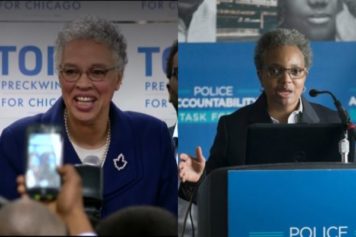The community of West Garfield Park in Chicago desperately needs resources and investment. Consistently one of the highest crime areas in the city, denizens of the predominantly African-American community on Chicago’s West Side have a per capita income of less than $11,000 annually, with a staggering 42 percent of households living below the poverty line. One out of four residents over the age of 25 does not possess a high school diploma.
Mayor Rahm Emmanuel is planning to spend a large sum of money in the troubled community. Two months ago, the embattled Chicago mayor proposed a $95 million plan to build a police and fire training academy on a 30-acre site in West Garfield Park. The facility is slated to include crime labs, classrooms, a shooting range, a driving course, an auditorium, a swimming pool, and extensive crisis simulation facilities.
It’s the wrong type of investment for the community, according to a sizable coalition of over two dozen youth groups and community organizations united in a campaign under the hashtag #NoCopAcademy.
“We demand a redirecting of this $95 million into Chicago’s most marginalized communities instead,” read an initial statement at the campaign’s website. “Real community safety comes from fully-funded schools and mental health centers, robust after-school and job training programs, and social and economic justice. We want investment in our communities, not expanded resources for police.”
The coalition has done much more than issue statements. For the past month the growing campaign — whose hashtag recently received the endorsement of Chicago Grammy-award winning artist Chance the Rapper — has publicly canvassed and engaged the city’s West Side and downtown citizens with numerous outdoor press conferences, rallies, call-ins to inform citizens, public protests and spirited demonstrations like “train takeovers.”
On October 10, over 100 members of participating groups blocked traffic outside City Hall with a large “people’s art installation” to protest both the proposed training academy and the city’s maintenance of a gang database. The evening rush hour demonstration was initiated by Organized Communities Against Deportation and Black Youth 100. Along with bar graphs charting the disparities between law enforcement budgeting and funds for public health and social services, coffins were installed to represent that “88 percent of the people hit or killed by the Chicago police between 2008 and 2015 are black or brown.”
“We want the $95 million to be put into the community, we want it to be put into schools, mental health clinics, jobs for teens, after-school programs, healthier lunches, and healthier grocery stores in impoverished neighborhoods,” said Nita Tennyson, a youth leader with Assata’s Daughters, a Chicago-based organization that empowers young African-American females. Tennyson noted that the city needs to “invest in the community, not the police.”
However, the city leadership sees a pressing need for such a facility to better train its officers, especially given a recent U.S. Justice Department investigation prompted by numerous high profile police killings of Black civilians by the Chicago Police Department. In the subsequent consent decree, the city agreed to “include reforms of CPD’s use of force practices and accountability mechanisms, as well as its training, community policing, supervision, data collection, transparency, officer wellness systems and promotion practices.”
“Our first responders deserve the best training to take on the challenges they face every day, and they deserve the best facility to learn and practice in,” Emanuel said in a July statement announcing the project. “Chicago’s new Public Safety Training Academy will provide a much-needed overhaul of the over 40-year-old training facilities currently used, and allow police officers, firefighters and paramedics to receive training based on the nation’s best practices.”
“I am pleased that West Garfield Park was selected by the Mayor for this important and long-lasting investment,” added Alderman Emma Mitts, whose 37th Ward includes the targeted location for the future development. “The thousands of first-responders reporting there for training every day will not only drive economic and community development throughout the neighborhood but also add a big public safety presence to our streets giving children and families more confidence as they travel about their lives.”
But Tennyson has no confidence in the investment, she told ABS. “The police in Chicago will always have negative confrontations with the people unless they change what they already know,” she said, contending “that doesn’t mean to buy a new facility, but to better their training.” However, the coalition, clarified Tennyson, is not in the training business and has more immediate concerns. “We want police accountability. We want police to stand up and say what they did wrong, and tell us if they are responsible.”
Tennyson further emphasized the significant impact that more holistic measures like art programs, conflict resolution training, peace circles and restorative justice circles can have on minimizing illegal activity, especially among youth. All of these processes could readily be implemented on the city’s troubled West Side with a small fraction of the proposed $95 million.
“Crime happens because there is nothing more positive going on in the neighborhood,” stressed Tennyson, noting that more police does not solve the problem. “If you bring in more positivity, you’ll have more positive outcomes.”


